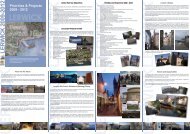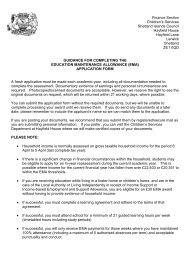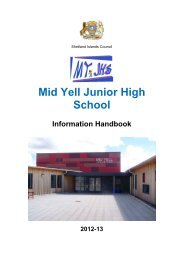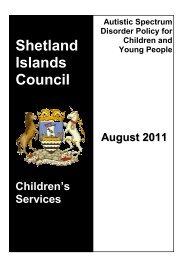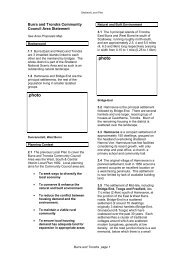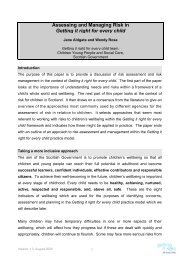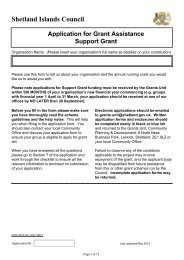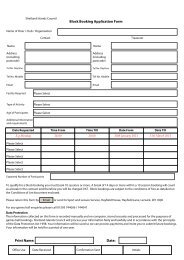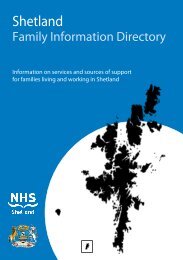Shetland Local Landscape Designation Review: Final Report
Shetland Local Landscape Designation Review: Final Report
Shetland Local Landscape Designation Review: Final Report
Create successful ePaper yourself
Turn your PDF publications into a flip-book with our unique Google optimized e-Paper software.
Candidate <strong>Local</strong> <strong>Landscape</strong> Area 4: Papa Stour and Sandness<br />
Location and boundaries:<br />
This area lies at the north-west corner of the west Mainland, and includes the island of Papa<br />
Stour.<br />
The southern boundary follows the ridge line of Ramna Vord and Sandness Hill which encloses<br />
the low-lying coast. It continues along field boundaries across Herma Neuk and The Spinner.<br />
The eastern boundary follows watercourses and lochs from the higher moorland down to<br />
Bousta. The eastern boundary is shared with the western boundary of candidate area 3:<br />
Vementry and West Burrafirth.<br />
Key characteristics:<br />
<br />
<br />
<br />
Intact settled coastal landscape with strong crofting-derived pattern<br />
The varied coast of Papa Stour, including high stacks, dramatic caves, and vertical cliffs, as<br />
well as sandy bays<br />
Sense of a long history of settlement within a contained and relatively remote part of the<br />
Mainland<br />
<strong>Designation</strong> statement:<br />
The area around Sandness represents an intact settled landscape, illustrating the traditional<br />
<strong>Shetland</strong> land-use pattern derived from crofting. The limited modern development in the area<br />
has been carried out in such a way that this pattern can still be read. Distinctive crofting field<br />
patterns can be seen in the landscape, backed by moorland which forms the common scattald.<br />
There are other historic features discernible in the landscape such as planticrubs and noosts that<br />
contribute to a strong sense of historic and cultural heritage.<br />
The stretch of coast along the mainland has a predominantly northern aspect, facing onto St<br />
Magnus Bay, across which wide views are afforded from much of the area. The low rounded hill<br />
at the Neap of Norby, which encloses the Sand of Gord, is a prominent feature. Here the coast<br />
comprises a series of small coves and beaches of shingle or white-grey sand. Inland the gradual<br />
descent from moorland to sea contrasts with the more rugged area east of Garth, where the<br />
Lewisian gneiss appears, running east into candidate area 3: West Burrafirth and Vementry.<br />
Located 1-2km offshore, the low-lying island of Papa Stour has a strong visual association with<br />
the Sandness area, with the settled part of the island facing the Mainland. The western coast of<br />
Papa Stour is particularly exposed, giving rise to varied and dramatic coastline of high vertical<br />
cliffs, arches, stacks and sea caves. On the more sheltered side of the island are found broad<br />
coves and wide sandy beaches as well as distinctive “scalped” heathland. Like the Mainland area<br />
around Sandness, the pattern of the crofting landscape can be read, but here it is even less<br />
affected by modern development.<br />
Located at the north-western tip of the west Mainland, the area retains a sense of remoteness<br />
and containment, though it is well visited. There is an element of surprise when arriving at the<br />
settlement from the desolate moorland to the south. Coastal walks are popular around Melby<br />
Beach and along the coast the Water Mills at Huxter and Woollen Mill at Sandness can be visited.<br />
Papa Stour is also a visitor destination.<br />
Development guidelines:<br />
<br />
<br />
<br />
Seek to retain the strong land-use pattern, ensuring a continuation of the sympathetic<br />
modern development of this area which have retained its cultural and natural values<br />
Promote responsible access and enable interpretation of the recent and distant past as well<br />
as the geological interest of the area<br />
Seek to conserve the historic features such as planticrubs, stone walls and noosts<br />
<strong>Shetland</strong> Islands <strong>Local</strong> <strong>Landscape</strong> <strong>Designation</strong> <strong>Review</strong><br />
Land Use Consultants<br />
<strong>Final</strong> <strong>Report</strong> 60 October 2011



